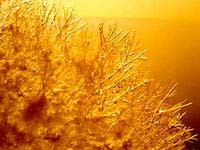Articles and reports from the Life Sciences and chemistry area deal with applied and basic research into modern biology, chemistry and human medicine.
Valuable information can be found on a range of life sciences fields including bacteriology, biochemistry, bionics, bioinformatics, biophysics, biotechnology, genetics, geobotany, human biology, marine biology, microbiology, molecular biology, cellular biology, zoology, bioinorganic chemistry, microchemistry and environmental chemistry.

ONR-sponsored Bonnie Bassler looks at bacterial communication
She thinks they’re everywhere. What’s more, she thinks they talk to each other.
But don’t snicker…ONR-sponsored Bonnie Bassler won a MacArthur Foundation ’genius award’ last year for her research on how some of the most deadly microbes we know – cholera, plague, TB, just to mention a few – communicate surprisingly well.
In her Princeton Lab, Bassler (and the rest of the microbiology community) calls it ’quor

Two papers in the May 1 issue of Genes & Development reveal unexpectedly widespread genomic binding by the Myc protein – prompting scientists to consider that this highly studied human oncogene may still have a few secrets to reveal.
Independent research groups led by Drs. Robert Eisenman (Fred Hutchinson Cancer Center) and Bruno Amati (European Institute of Oncology) report on the first genome-wide analyses of in vivo Myc targets in the Drosophila and human genomes, respectively. As the my

As a fiber, spider silk is so desirable that scientists have spent decades trying to find a way to mimic it. A team at MIT has been tackling the problem from two directions.
“The main goal is to be able to reproduce the enormous energy absorption and strength-bearing properties of spider silk,” said Paula T. Hammond, an associate professor in MIT’s Department of Chemical Engineering. “[We want] to be able to obtain a material in large quantities and cheaply … without DNA techniques, which a

New knowledge will provide insight into organisms important to agriculture, medicine, the environment and commerce
In the April 24, 2003, issue of the journal Nature, scientists, including UC Riverside’s Katherine A. Borkovich, assistant professor in the department of plant pathology, and her postdoctoral fellow, Svetlana Krystofova, present the entire list of genes found in the Neurospora genome. (A genome is all the DNA in an organism, including its genes.) The scientists’ analysis

Humans are not alone in creating ‘signposts’ to help them find their way, according to new research published in the open access journal BMC Ecology. Wood mice, say scientists, move objects from their environment around using them as portable signposts whilst they explore.
The finding is significant as this is the first time such sophisticated behaviour has been identified in any mammal except humans. According to the authors,
“This is precisely how a human might tackle the pro

Researchers at Oxford University’s Department of Biochemistry have developed methods for making RNA duplexes and single-stranded RNAs of desired length and sequence. This exciting technology is most applicable to commercial RNA providers and companies with large in-house requirements for RNA molecules as it will greatly increase cost-effectiveness.
Small interfering ribonucleic acids (siRNAs) are powerful laboratory tools for directed post- transcriptional gene expression knockdown and inhi